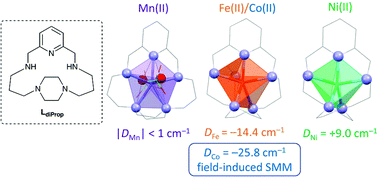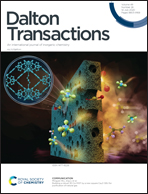Late first-row transition metal complexes of a 17-membered piperazine-based macrocyclic ligand: structures and magnetism†
Abstract
A 17-membered piperazine-based macrocyclic ligand LdiProp (1,5,13,17,22-pentaazatricyclo[15.2.2.17,11]docosa-7,9,11(22)-triene) was resynthesized in high yield by using a linear pump. Its Mn(II), Fe(II), Co(II) and Ni(II) complexes of the general formula [MnLdiProp(ClO4)2] (1), [FeLdiProp(CH3CN)](ClO4)2 (2), [CoLdiProp(CH3CN)](ClO4)2 (3), [NiLdiProp](ClO4)2 (4) were prepared and thoroughly characterized. X-ray diffraction analysis confirmed that Mn(II) complex 1 has capped trigonal prismatic geometry with a coordination number of seven, Fe(II) and Co(II) complexes 2 and 3 are trigonal prismatic with a coordination number of six and Ni(II) complex 4 has square pyramidal geometry with a coordination number of five. The decrease of the coordination number is accompanied by a shortening of M–N distances and an increase of torsion of the piperazine ring from the equatorial plane. Magnetic measurement reveals moderate anisotropy for 4 and rather large magnetic anisotropy for 2 and 3 (axial zero-field splitting parameter D(Ni) = 9.0 cm−1, D(Fe) = −14.4 cm−1, D(Co) = −25.8 cm−1, together with rather high rhombicity). Co(II) complex 3 behaves as a field-induced SMM with a combination of Raman and direct or Orbach and direct relaxation mechanisms. Obtained magnetic data were extensively supported by theoretical CASSCF calculations. The flexibility and rather large 17-membered macrocyclic cavity of ligand LdiProp could be responsible for the variation of coordination numbers and geometries for the investigated late-first row transition metals.



 Please wait while we load your content...
Please wait while we load your content...